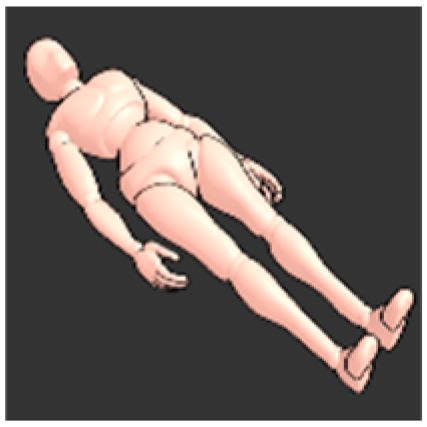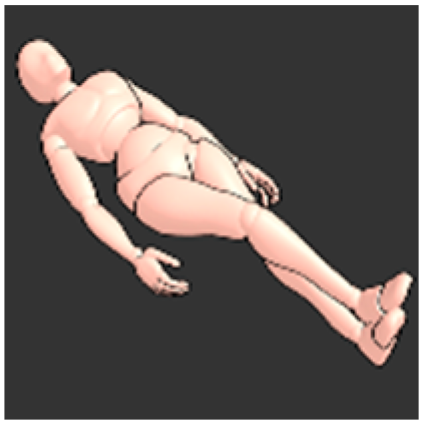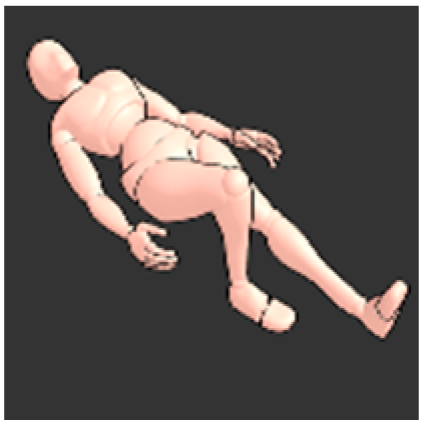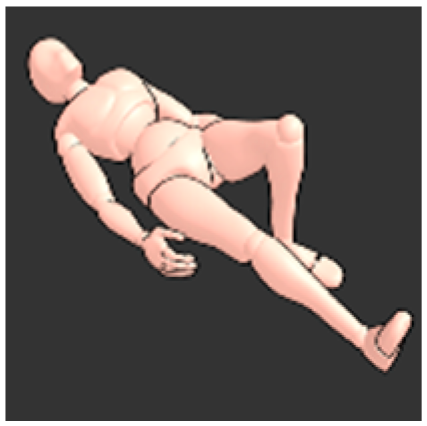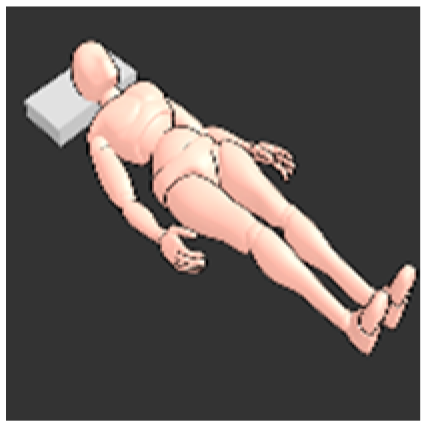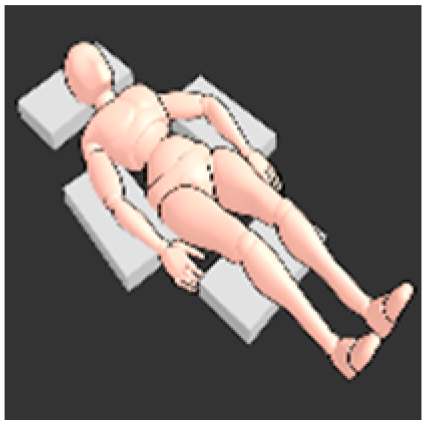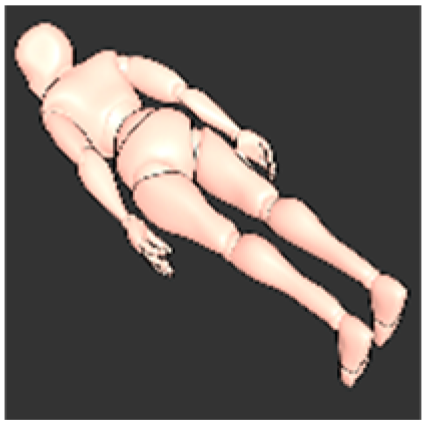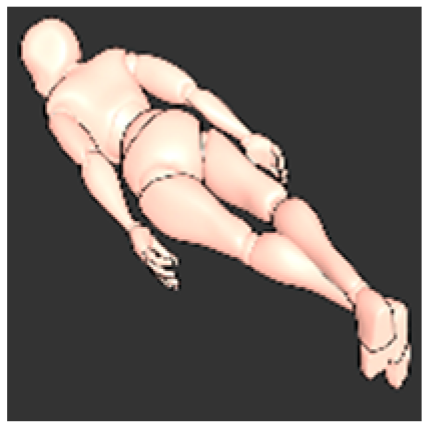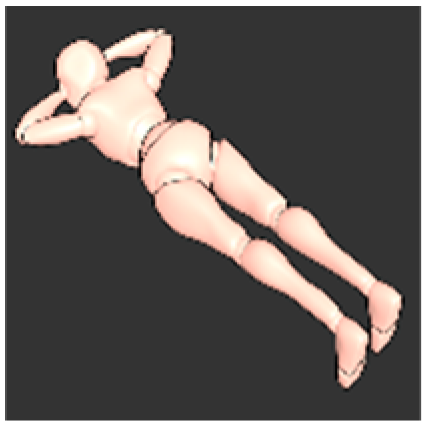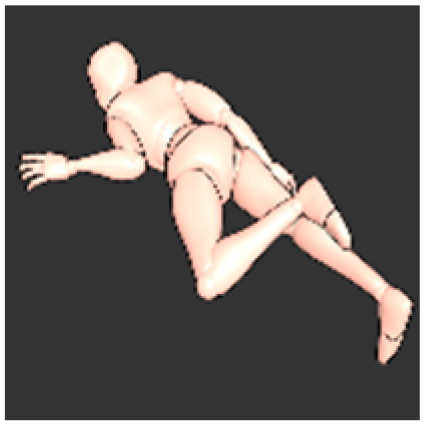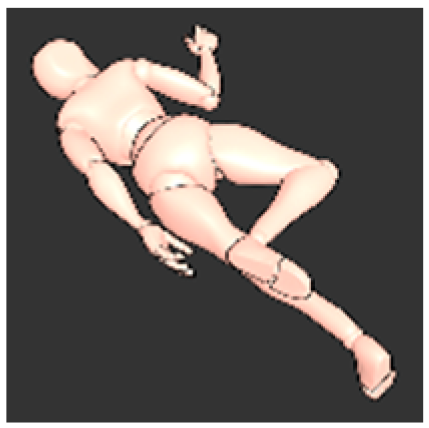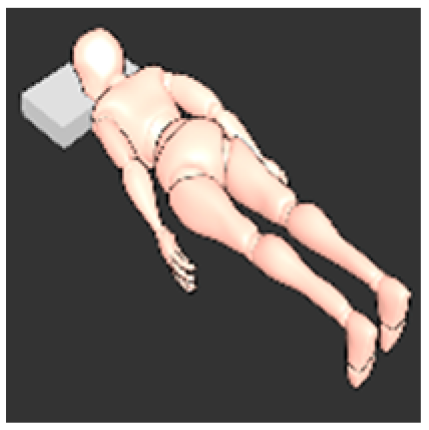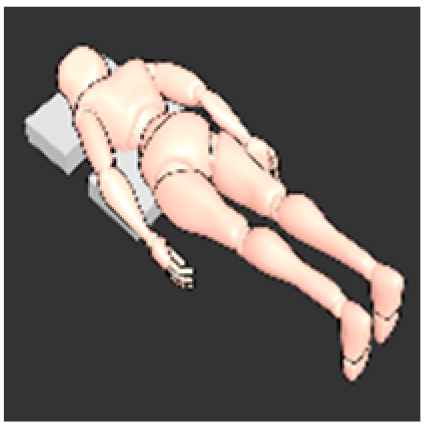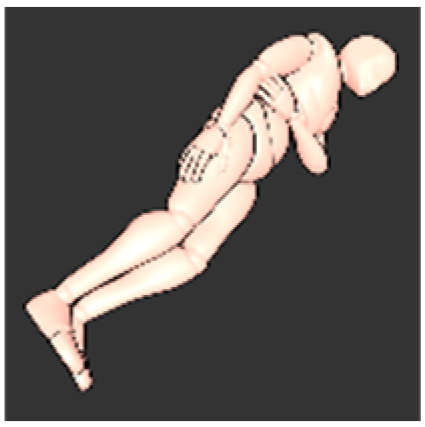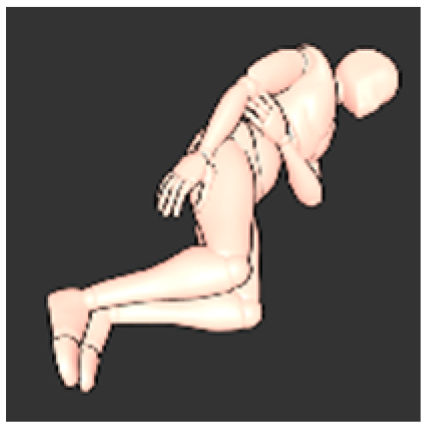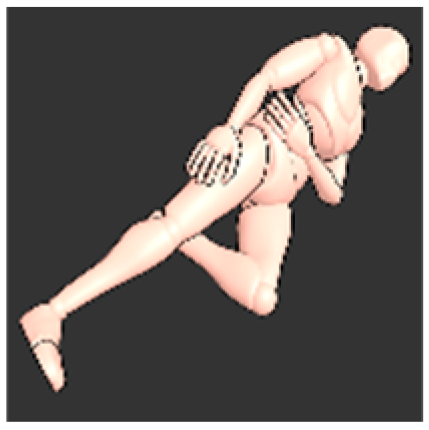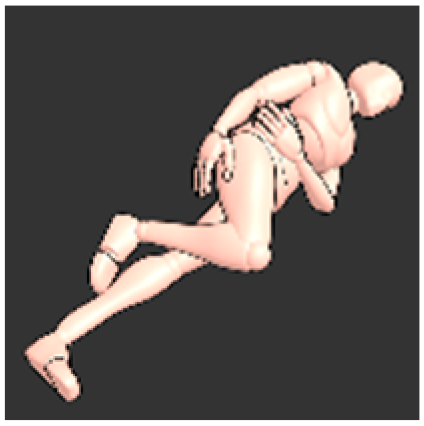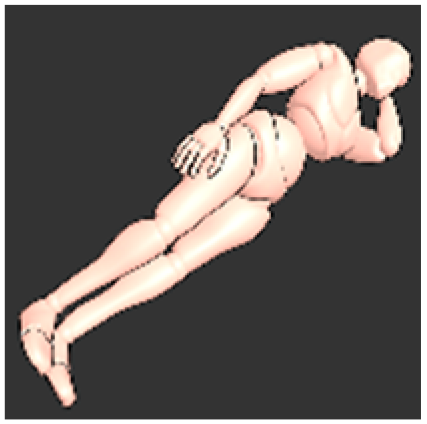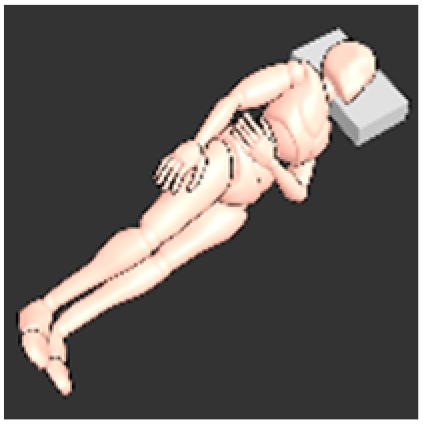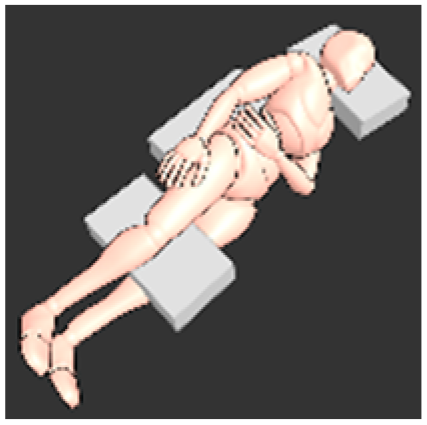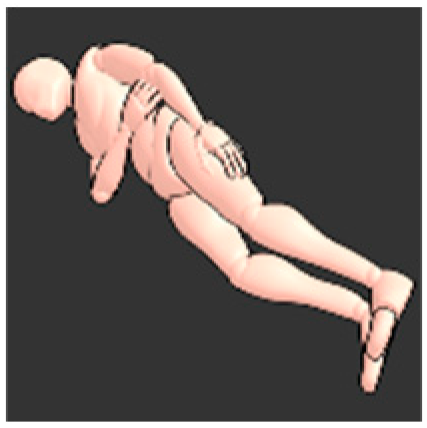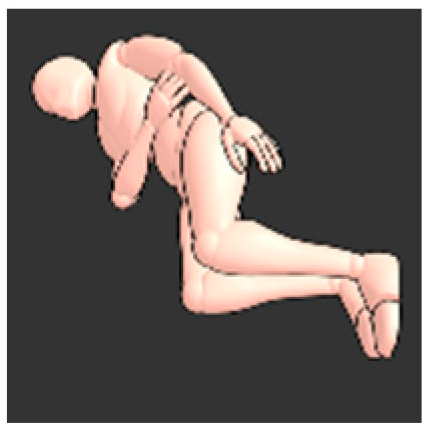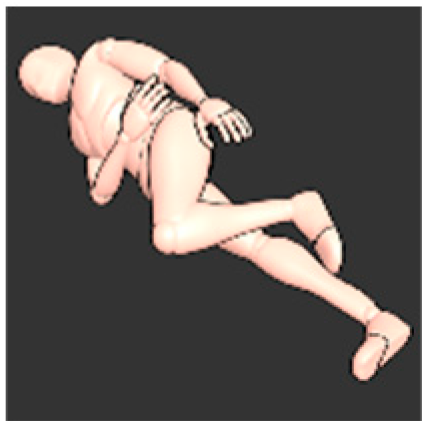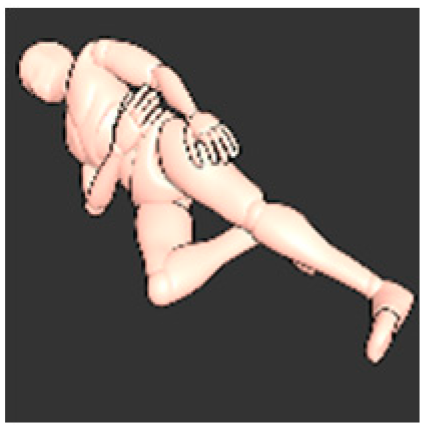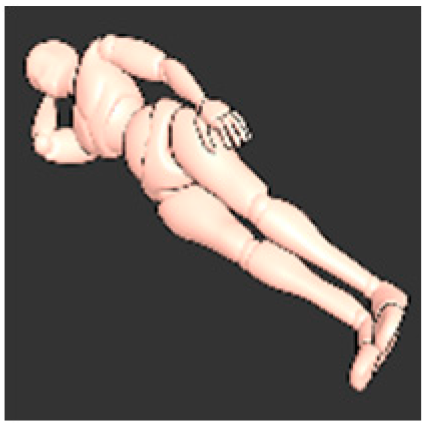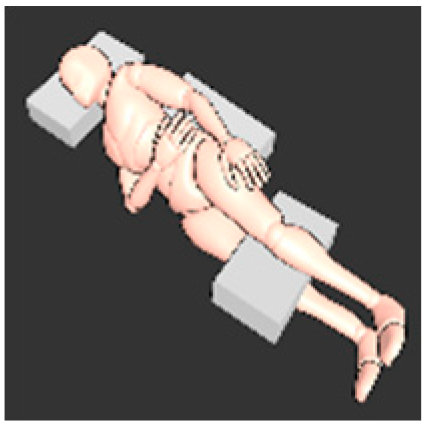Abstract
This study presents a dataset containing three layers of data that are useful for body position classification and all uses related to it. The PoPu dataset contains simultaneously collected data from two different sensor sheets—one placed over and one placed under a mattress; furthermore, a segmentation data layer was added where different body parts are identified using the pressure data from the sensors over the mattress. The data included were gathered from 60 healthy volunteers distributed among the different gathered characteristics: namely sex, weight, and height. This dataset can be used for position classification, assessing the viability of sensors placed under a mattress, and in applications regarding bedded or lying people or sleep related disorders.
Dataset
The dataset is available on GitHub: https://github.com/rdionisio1403/PoPu/.
Dataset License
The dataset is available under Creative Commons (CC0).
1. Summary
Bedded or lying-people pressure-maps can be used to identify patient positions and behaviors and can be very useful in numerous healthcare applications. The development of these applications normally requires the training and validation of algorithms based on datasets with a high number of pressure maps that represent different people in different positions and conditions. However, building these datasets is a laborious and time-consuming task, as it is necessary to involve a large number of participants who have to carry out a set of predefined behaviors and movements that are recorded and classified. For this reason, researchers tend to use public datasets to carry out their experiments and validate their solutions. However, to be useful, these datasets should have certain criteria: namely, regarding the quality of the data and containing sufficient samples to characterize a given population.
A study on pressure-map datasets [] conducted a review through three databases (Scopus, Web of Science, and PubMed). Compared to the other datasets referenced in this study, this dataset includes a greater number of positions that are labelled accordingly, a high number of samples, and well-distributed, relevant participant characteristics.
This study aims to create a dataset that contains the data not only from a commercial sensor sheet placed directly below the subjects, but also from sensors below a mattress, along with relevant participant characteristics and body part segmentation information.
The resulting dataset includes data from 60 individuals lying in 28 different positions, with 7 variations of each of the 4 main positions that are found in most of the literature—supine, prone, facing left, and facing right. Additionally, for all variations, the participants were asked to shift their body slightly twice, in order to increase the variety of the data samples, which ultimately resulted in 50,400 pressure data samples and 1680 segmentation images.
This dataset can be used for assessing the viability of sensors placed under a mattress, and all its layers can be used for classification algorithms similar to the work researchers conducted in [,,,], as well as health studies related to pressure ulcers [], sleep disorders [], and fall prevention, among others.
2. Data Description
This section contains the information regarding the data included in the dataset. First the different positions considered for the data gathering process, then a description of the participants and the distributions of the data gathered and finally a description of the organization of the data, from the different files to the format of the data in each file.
2.1. Pressure-over- and Pressure-under (PoPu)-Mattress Dataset
Prior to the collection of the pressure data, the most common sleeping or lying positions were searched; most literature includes four positions (supine, prone, facing left and facing right); therefore, for this dataset, the positions were organized into these four main positions and the rest were considered variations. Table 1 displays all of the 28 positions considered and how they are organized. For each of the main positions, two variations also included pillow placement with the intent of analyzing its influence on the pressure data.

Table 1.
Different positions and variations considered.
2.2. Participant Characteristics
A total of 60 healthy individuals participated in the data collection process and had their weight, height, and sex registered along with the pressure data. The weight of the participants, with their distribution shown in Figure 1, ranged from 45 kg to 127 kg (the average weight was 74.25 with a standard deviation of 17.6), the height ranged from 145 cm to 195 cm (the average was 171.9 with a standard deviation of 10.3) with the distribution shown in Figure 2, and the sex distribution was 24 females (40%) and 36 males (60%).
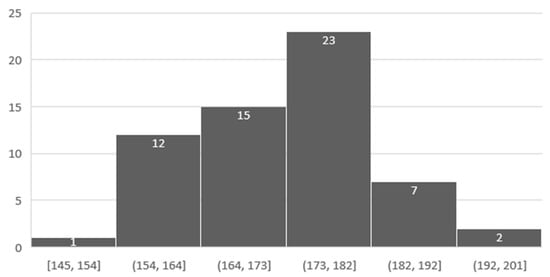
Figure 1.
Participants’ weight distribution.
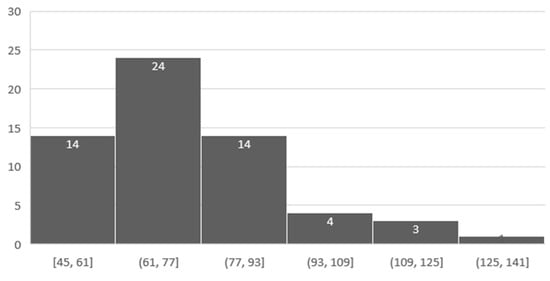
Figure 2.
Participants’ height distribution.
2.3. Dataset Format Description
This dataset’s files use the JSON (JavaScript Object Notation) format, as it is widely used and can easily be formatted by researchers if necessary. The dataset is split in three folders that represent each of the layers, with each containing one folder for each of the 60 volunteers. The three initial folders represent the pressure data from the sensors under the mattress (“sensomatt_data” folder), the pressure data from the sensors over the mattress (“tactilus_data” folder), and the segmentation results (“segmentation_data” folder).
Regarding the pressure data folders, each of the volunteer folders contains three files for every position considered, named after the position (for a total of 84 files), with an indication for each shift in the same position. For example, for data concerning the supine position in the first variation, the file will be named “supine1_0”; the file for the same variation after a slight shift from the volunteer will either be named “supine1_1” or “supine1_2”. Each of the files contains 10 samples.
Other than the files corresponding to each position, there is also a file, named “empty1” which contains samples taken while there was no volunteer on the sensors, which can be used to remove any initial noise from the data. There is also a file named “others” which contains samples that were taken throughout the data-gathering process but which are not labeled as to the position the participant was in.
In the “segmentation_data” folder, each of the volunteer folders contains one file for every position considered, named similarly to the pressure data folders, with the slight difference that there is only one file for each position, so for the same position above, there would be one file named “supine1”. There is also a folder with images obtained from the segmentation files—one for each of the positions.
The structure of the folders is represented in the following tree:
└── PoPu_data/
├── sensomatt_data/
│ ├── 1(volunteer_id)/
│ │ └── <position+variation_json_data_files_with_bottom_pressure_data>
│ ├── (...)
│ └── 60(volunteer_id)/
│ └── <position+variation_json_data_files_with_bottom_pressure_data>
├── tactilus_data/
│ ├── 1(volunteer_id)/
│ │ └── <position+variation_json_data_files_with_top_pressure_data>
│ ├── (...)
│ └── 60(volunteer_id)/
│ └── <position+variation_json_data_files_with_top_pressure_data>
└── segmentation_data/
├── 1(volunteer_id)/
│ ├── <position+variation_json_files_with_segmentation_results>
│ └── <segment_images_folder>/
│ └── <position+variation_segment_image>
├── (...)
└── 60(volunteer_id)/
├── <position+variation_json_files_with_segmentation_results>
└── <segment_images_folder>/
└── <position+variation_segment_image>
Each of the pressure map file’s content is organized as follows:
{
volunteer_id: <identifier_for_volunteer>,
sex: <sex_of_volunteer>,
height: <height_of_volunteer_in_cm>,
weight: <weight_of_volunteer_in kg>,
<sensor_sheet_name>_columns: <number_of_columns>,
<sensor_sheet_name>_rows: <number_of_rows>,
position: <position_of_volunteer>,
variation: <variation_number>,
snapshots: {
0: {
id: <identifier_generated_for_specific_sample>,
<sensor_sheet_name>_readings: [<list_of_values_from_sensor_sheet>
}
(…)
10: {
id: <identifier_generated_for_specific_sample>,
<sensor_sheet_name>_readings: [<list_of_values_from_sensor_sheet>
}
}
The “others” file on the pressure data folders has a similar structure but without the position and variation labels.
The segmentation files have one file for each position, using the pressure data from the top sensor sheet’s data (tactilus_data). The organization of the segmentation files is as follows:
{
id: <image_name>,
annotations: [
{
id: <body_part_number_in_image>,
completed_by: 1,
result: [<list_of_polygons_found_in_image>
{
original_width: <image_width>,
original_height: <image_height>,
image_rotation: <image_rotation>,
value: {
points: [ <list_of_polygon_vertices_(ordered_clockwise)>
[<x>,<y>],
(...)
[<x>,<y>]
],
closed: <true_if_polygon_closed_false_otherwise>,
polygonlabels: [<name_of_body_part>]
},
id: <randomly_generated_id>,
from_name: “label”,
to_name: “image”,
type: “polygonlabels”,
origin: “manual”
},
(...rest_of_polygons…)
],
<info_regarding_segmentation_process_(omitted)>
}
],
file_upload: <segmentation_image_name>,
<info_regarding_image_(omitted)>
}
Since the “others” file has no associated position, it is not included in the “segmentation_data” folder.
With these files, a pressure image can be generated, as seen in Figure 3, and the different pressure values can be observed along with the different segments on the data files.
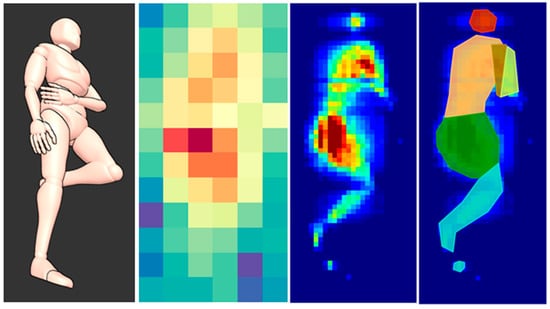
Figure 3.
Different images from data included in PoPu dataset, from left to right: example 3D-modelled position, bottom sensors pressure map, top sensors pressure map, segmentation image.
Figure 3 shows 3 different images from the same volunteer in the facing-left position and in variation 3.
3. Methods
This section contains the methods used to collect the data. The materials used will be described, along with a description of how they were used during the data collection, in terms of hardware and the software developed for the data-gathering procedure. Then, a description of the experimental setup is provided. Lastly, the experimental procedure’s details are given.
3.1. Equipment
For this experiment, two different sensor sheets were used: one placed on top of a standard viscoelastic, single-piece, foam hospital mattress (195 cm × 85 cm × 16 cm) and the other placed under it.
The sheet placed over the mattress was a commercially available, 180 cm × 78 cm Tactilus sensor sheet [] with a total of 1728 piezoelectric sensors evenly distributed in a 27 × 64 matrix. Each of the sensors output a pressure value between 0 and 100 mmHg.
The Sensomatt sensor sheet, placed under the mattress, contained 72 single cells, designed to detect omnidirectional contact pressure induced by soft contact such as mattress foam contact. The sensor cells are registered under Portugal Intellectual Property law with the patent number: 117507.
Sensor cells could be arranged in any different configuration, but in this experiment, they were arranged in 12 × 6 matrix distributed over the 170 × 84 surface of the sheet.
Apart from the sensor sheets, both a hospital bed and mattress were used throughout the process. When required by the predetermined positions, different-sized pillows were used, with dimensions of either 50 cm × 70 cm or 30 cm × 50 cm. A scale was used to measure the weight and a tape measure was used to measure the height of the volunteers.
3.2. Setup
The bed was placed in a room, shown in Figure 4, where only the volunteers and the researchers responsible for data gathering were present. The sheets were placed over and under the mattress as shown in Figure 5 and secured to avoid excessive movement as the volunteers shifted their position as instructed. The sheets were connected to a computer on which the data were recorded.

Figure 4.
Data-gathering procedure material and environment.

Figure 5.
Sensor sheet placement diagram.
To ensure the data were synchronized, a program was developed to collect the data from both sensor sheets at the same time, and they were saved into 10 frames over a short period—only after it has been observed that the volunteer had shifted to the correct position. The program was developed to ensure that the data were gathered at the same instant by using multithreaded programming.
3.3. Experimental Procedure
All volunteers were asked to lie down in the same positions and in the same order to guarantee the dataset was accurate and usable by future researchers, and to ensure these conditions were met, the volunteers were first given a consent form and informed of the actions they would need to perform. Furthermore, they were informed prior to the experiment that they should not be wearing thick clothing, to ensure that the pressure images would not contain any noise related to it.
The following step consisted of the volunteers removing any items from their pockets along with any protruding items of clothing (i.e., belts, bracelets, watches) and removing their shoes. The weights and heights of the volunteers were then taken and registered in the software. After these steps, the volunteers were asked to lie down on the bed and assume the first of the 28 total positions comfortably.
Once they assumed the first position, the researcher in charge of data collection would initiate the data-gathering program and once it was completed the volunteer was then instructed to shift their position slightly twice and wait for the data to be gathered before moving on to the next position. When the position required the usage of pillows, they were given to the volunteers and placed wherever necessary by one of the researchers with healthcare knowledge.
To ensure the validity of the data, all the volunteers went through the exact same process, with the order of the positions being established prior to the data collection procedure.
The body segmentation, which was added after the data gathering was complete, was achieved via manual annotation by a minimum of 2 researchers (maximum 3) to ensure its validity, assisted by a commercially available annotation tool []. The annotation process was performed based on a colorized pressure heatmap for each volunteer in each position. These annotations were considered based on analyzing different layers with varying contrasts, to increase the accuracy. The annotation was conducted for a maximum of 6 body zones, along with a background zone (which is not reported), depending on the visibility of the body from the pressure heatmap. The accuracy of the data ground truth relies on the visibility of pressure induced by body elements on the pressure sensor. It was also ensured by the 28 predefined positions in which volunteers were requested to position themselves in specific ways.
4. Limitations
Despite attempting to generate a diverse dataset that would represent all body types, for better algorithmic results when applied to machine learning or similar studies, it should be noted that there are some limitations as to the dataset’s range of applications.
The data gathered from both the sensor sheets might not be representative of populations in distinct geographical regions, as the vast majority of the volunteers in this study were local to the country where the study was conducted.
The bottom-layer data are dependent on the mattress used in the data-gathering process; although this procedure used a standard hospital mattress, as described in Section 3.1, mattresses that change in density, for example, will dissipate the pressure differently and will achieve different results.
Regarding the segmentation layer, the amount of data available is limited to one per position instead of thirty different samples.
Author Contributions
Conceptualization, L.F., F.R., J.M. and R.D.; methodology, L.F., F.R., J.M., A.S., R.D., M.M.A., D.F.S., A.R.H. and S.S.A.; software, L.F., M.M.A., A.R.H., D.F.S. and S.S.A.; validation, L.F. and M.M.A.; formal analysis, L.F. and M.M.A.; investigation, L.F., A.S., F.R., J.M., R.D., M.M.A., A.F.S., A.R.H., D.F.S., F.F., F.B.R., O.S., P.C. and S.S.A.; data curation, L.F. and A.S.; writing—original draft preparation, L.F. and F.R.; writing—review and editing, L.F., F.R., J.M. and R.D.; supervision, F.R. and P.C.; project administration, R.D., F.B.R. and M.M.A. All authors have read and agreed to the published version of the manuscript.
Funding
This work was carried out under the SensoMatt project, grant agreement no. CENTRO-01-0247-FEDER-070107, co-financed by European Funds (FEDER) by CENTRO2020.
Institutional Review Board Statement
The study was conducted in accordance with the Declaration of Helsinki, and approved by the Ethics Committee of the Polytechnic Institute of Castelo Branco (protocol code 36 CE-IPCB/2021).
Informed Consent Statement
Informed consent was obtained from all subjects involved in the study.
Data Availability Statement
The data presented in this study are openly available in GitHub: https://github.com/rdionisio1403/PoPu/ access on 1 July 2023.
Conflicts of Interest
The authors declare no conflict of interest.
References
- Fonseca, L.; Ribeiro, F.; Metrôlho, J. Lying-People Pressure-Map Datasets: A Systematic Review. Data 2023, 8, 12. [Google Scholar] [CrossRef]
- Russo, A.; Licciardo, G.D.; Di Benedetto, L.; Rubino, A.; Liguori, R.; Naddeo, A.; Cappetti, N. Quantized Fully Convolution Neural Network for HW Implementation of Human Posture Recognition. In Proceedings of the 2021 IEEE 3rd International Conference on Artificial Intelligence Circuits and Systems, AICAS 2021, Washington, DC, USA, 6–9 June 2021. [Google Scholar] [CrossRef]
- Channa, A.; Yousuf, M.; Popescu, N. Machine Learning Algorithms for Posture Identification of Obstructive Sleep Apnea Patients using IoT Solutions. In Proceedings of the 2020 8th E-Health and Bioengineering Conference, EHB 2020, Iasi, Romania, 29–30 October 2020. [Google Scholar] [CrossRef]
- Dam, H.P.; Pham, N.D.A.; Pham, H.M.; Doan, N.P.; Nguyen, D.M.; Nguyen, H.H. In-bed posture classification using pressure sensor data and spiking neural network. In Proceedings of the 2021 8th NAFOSTED Conference on Information and Computer Science, NICS 2021, Hanoi, Vietnam, 21–22 December 2021; pp. 358–363. [Google Scholar] [CrossRef]
- Stern, L.; Roshan Fekr, A. In-Bed Posture Classification Using Deep Neural Network. Sensors 2023, 23, 2430. [Google Scholar] [CrossRef] [PubMed]
- Silva, A.; Metrôlho, J.; Ribeiro, F.; Fidalgo, F.; Santos, O.; Dionisio, R. A Review of Intelligent Sensor-Based Systems for Pressure Ulcer Prevention. Computers 2022, 11, 6. [Google Scholar] [CrossRef]
- Tactile Surface Sensor|Real-Time Surface Pressure Mapping Technology|Pressure Pad|Force Sensitive Resistor|Matrix Tactile Sensor|Pressure Mapping System FSR. Available online: https://tactilus.net/ (accessed on 1 June 2023).
- Roboflow Annotate. Available online: https://roboflow.com/annotate (accessed on 30 June 2023).
Disclaimer/Publisher’s Note: The statements, opinions and data contained in all publications are solely those of the individual author(s) and contributor(s) and not of MDPI and/or the editor(s). MDPI and/or the editor(s) disclaim responsibility for any injury to people or property resulting from any ideas, methods, instructions or products referred to in the content. |
© 2023 by the authors. Licensee MDPI, Basel, Switzerland. This article is an open access article distributed under the terms and conditions of the Creative Commons Attribution (CC BY) license (https://creativecommons.org/licenses/by/4.0/).
